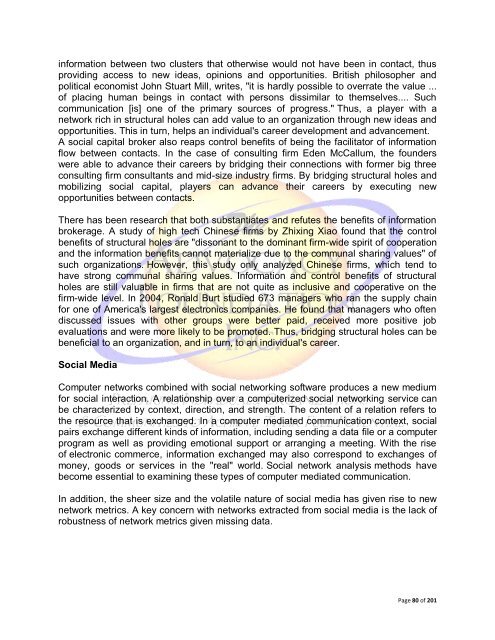ComeUnity CAPACITY BUILDING
ComeUnity CAPACITY BUILDING
ComeUnity CAPACITY BUILDING
You also want an ePaper? Increase the reach of your titles
YUMPU automatically turns print PDFs into web optimized ePapers that Google loves.
information between two clusters that otherwise would not have been in contact, thus<br />
providing access to new ideas, opinions and opportunities. British philosopher and<br />
political economist John Stuart Mill, writes, "it is hardly possible to overrate the value ...<br />
of placing human beings in contact with persons dissimilar to themselves.... Such<br />
communication [is] one of the primary sources of progress." Thus, a player with a<br />
network rich in structural holes can add value to an organization through new ideas and<br />
opportunities. This in turn, helps an individual's career development and advancement.<br />
A social capital broker also reaps control benefits of being the facilitator of information<br />
flow between contacts. In the case of consulting firm Eden McCallum, the founders<br />
were able to advance their careers by bridging their connections with former big three<br />
consulting firm consultants and mid-size industry firms. By bridging structural holes and<br />
mobilizing social capital, players can advance their careers by executing new<br />
opportunities between contacts.<br />
There has been research that both substantiates and refutes the benefits of information<br />
brokerage. A study of high tech Chinese firms by Zhixing Xiao found that the control<br />
benefits of structural holes are "dissonant to the dominant firm-wide spirit of cooperation<br />
and the information benefits cannot materialize due to the communal sharing values" of<br />
such organizations. However, this study only analyzed Chinese firms, which tend to<br />
have strong communal sharing values. Information and control benefits of structural<br />
holes are still valuable in firms that are not quite as inclusive and cooperative on the<br />
firm-wide level. In 2004, Ronald Burt studied 673 managers who ran the supply chain<br />
for one of America's largest electronics companies. He found that managers who often<br />
discussed issues with other groups were better paid, received more positive job<br />
evaluations and were more likely to be promoted. Thus, bridging structural holes can be<br />
beneficial to an organization, and in turn, to an individual's career.<br />
Social Media<br />
Computer networks combined with social networking software produces a new medium<br />
for social interaction. A relationship over a computerized social networking service can<br />
be characterized by context, direction, and strength. The content of a relation refers to<br />
the resource that is exchanged. In a computer mediated communication context, social<br />
pairs exchange different kinds of information, including sending a data file or a computer<br />
program as well as providing emotional support or arranging a meeting. With the rise<br />
of electronic commerce, information exchanged may also correspond to exchanges of<br />
money, goods or services in the "real" world. Social network analysis methods have<br />
become essential to examining these types of computer mediated communication.<br />
In addition, the sheer size and the volatile nature of social media has given rise to new<br />
network metrics. A key concern with networks extracted from social media is the lack of<br />
robustness of network metrics given missing data.<br />
Page 80 of 201

















